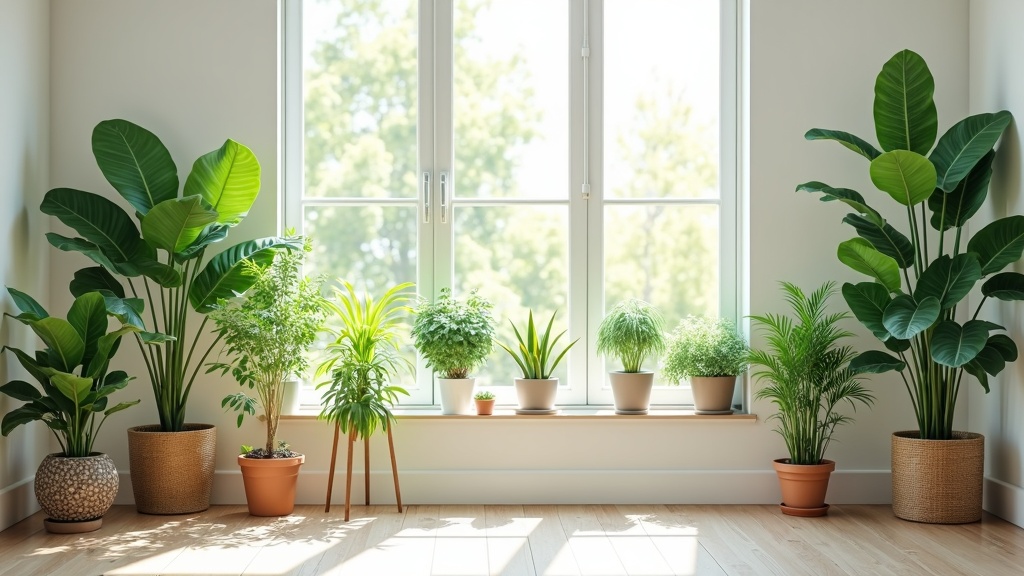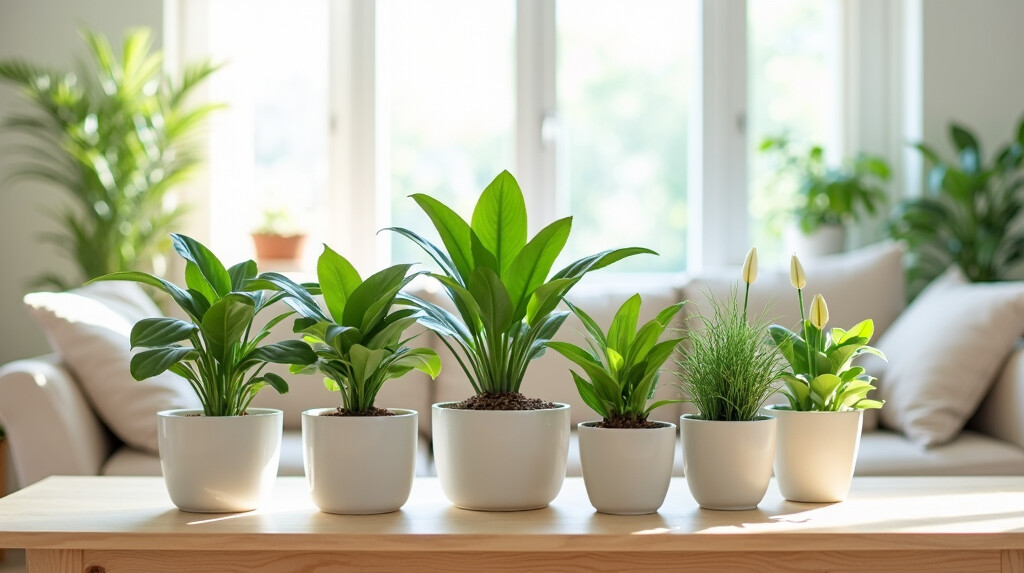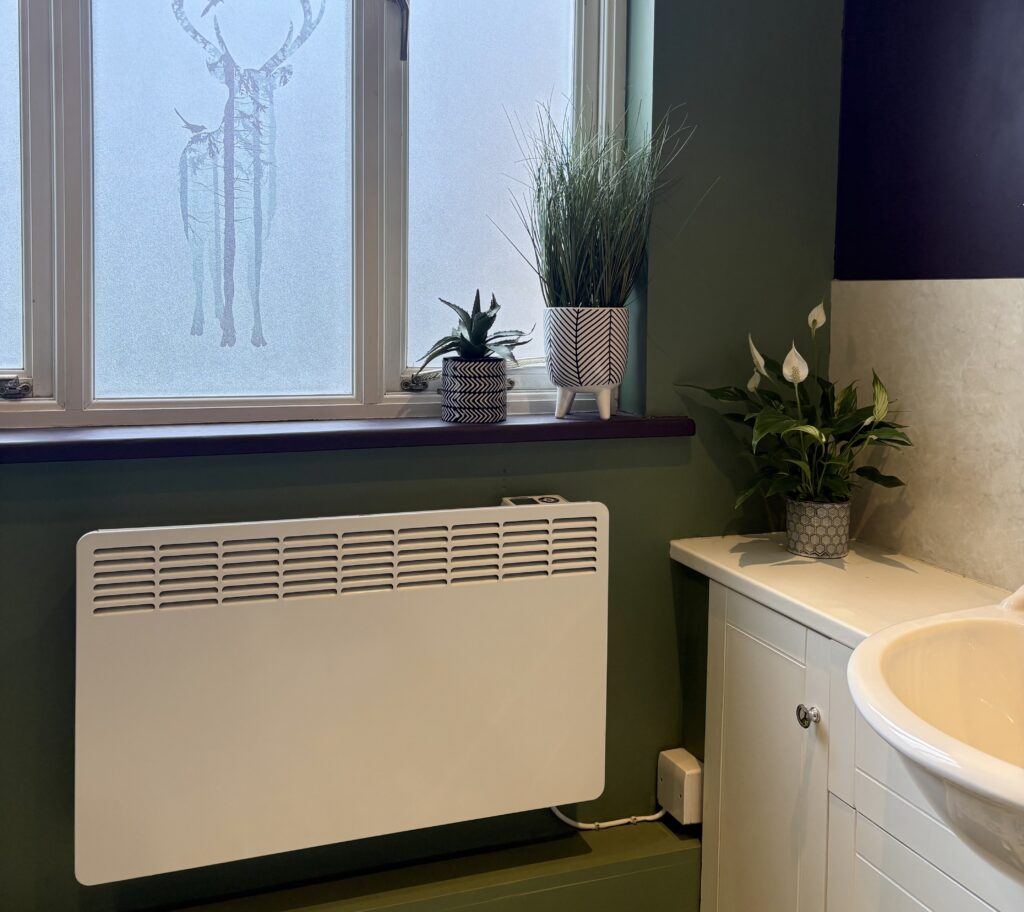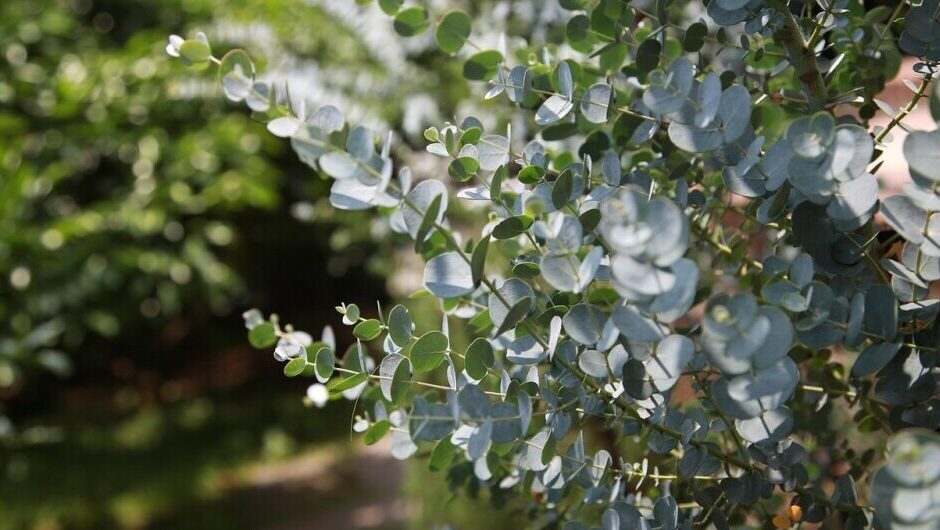15 Best Indoor Plants for Air Purification (Pet-Safe Options & Care Tips)
Discover the best indoor plants for air purification, from peace lily to snake plant. Get pet-safe options, room-by-room suggestions, and easy care tips for a fresher, healthier home.
If you’re looking for an easy way to freshen the air in your home and add a bit of style at the same time, indoor plants for air purification are a pretty cool option. Houseplants aren’t just about looking good; they can help reduce common toxins and even boost your mood. But it’s important to know how much real impact plants can have in your space, and how to pick the right ones for your needs.
Hello & welcome, My love of gardening spills over into my home, too. What started with a single anniversary orchid quickly grew into a full-blown passion for indoor plants. Over the years I’ve learned how to create cosy, green corners with houseplants that thrive, and now I share simple, confidence-boosting tips to help others enjoy the calm and colour that indoor plants bring to everyday life.
Garden Nest Living grew from a simple idea: to share my love of gardens and creating calm, beautiful spaces, both inside and out. When you buy through my affiliate links, you are allowing me to keep sharing inspiration, ideas and products… at no extra cost to you. Thank you for being a part of my journey!

Do Indoor Plants Really Purify the Air?
NASA’s Clean Air Study Explained
Back in 1989, NASA ran the famous Clean Air Study to see which common houseplants could clean the air inside sealed environments; think space stations, not your typical bedroom. Their tests showed certain plants could absorb harmful chemicals like benzene, formaldehyde, and trichloroethylene.
What’s interesting, and not always talked about, is that it’s not just the plant itself doing the heavy lifting. Healthy soil loaded with good microbes also helps break down nasty chemicals. This means that keeping your plant’s soil in good condition can make a real difference in how effective your indoor garden becomes for air cleaning.
Modern Expert Perspectives on Real-World Effectiveness
While the NASA Clean Air Study is often cited as proof that houseplants can scrub toxins from indoor air, experts today point out that its results came from sealed chambers—conditions very different from the average home with open windows, doors, and air circulation. More recent research suggests that while plants do contribute to cleaner air, the effect is modest compared to mechanical air purifiers or good ventilation. That said, plants still play an important role in improving indoor environments by boosting humidity, reducing mould in damp spaces, and enhancing mental well-being. In other words, while you shouldn’t rely on houseplants alone for air quality, they remain a valuable and natural complement to other healthy home practices. (Drexel University had two experts perform a study & they recorded their results.)
Top 15 Air Purifying Indoor Plants (with Real Benefits)
So, which indoor plant purifies the air the most? According to the NASA study and more recent indoor air research, the peace lily and snake plant stand out for grabbing a range of airborne toxins. Spider plant is another favourite because it’s really easy to care for and pulls chemicals like formaldehyde and xylene out of the air. But there are plenty of other plants you can choose based on your space, style, and whether you have pets.
Peace Lily – Best Overall for Multiple Toxins & Mould (Spathiphyllum)
- Filters formaldehyde, benzene, trichloroethylene, xylene, and ammonia. The peace lily is notable for reducing mould spores, which is awesome for bathrooms or humid rooms.
Snake Plant – Best Low-Light Plant for Bedrooms (Sansevieria trifasciata)
- Fights formaldehyde, benzene, xylene, toluene, and nitrogen oxides. It keeps working even at night to release oxygen, making it super useful in bedrooms for better sleep quality.
Spider Plant – Best Beginner-Friendly & Pet-Safe Plant (Chlorophytum comosum)
- Easy to keep alive and removes formaldehyde, xylene, and toluene. This resilient plant bounces back from neglect and adapts to most rooms.
Aloe Vera – Best Dual-Purpose Plant (Air + Skin Care) (Aloe barbadensis miller)
- Cleans up formaldehyde and benzene while being great for your skin if you get a scratch or burn. Just give it bright, indirect light and minimal watering, and it thrives on its own.
Boston Fern – Best for Bathrooms & Humid Rooms (Nephrolepis exaltata)
- Removes formaldehyde and xylene. This plant prefers a humid environment and works best in a bathroom or kitchen where the air is a bit wetter.
English Ivy – Best Trailing Plant for Shelves & Baskets (Hedera helix)
- Targets formaldehyde, benzene, xylene, and toluene. Great for hanging baskets or letting trail down bookshelves. Keep in mind this plant is toxic to pets.
Rubber Plant – Best Glossy Foliage for Living Rooms (Ficus elastica)
- Famous for removing formaldehyde. The rubber plant looks super glossy all year and thrives in bright, indirect light.
Golden Pothos – Best Fast-Growing Low-Maintenance Plant (Epipremnum aureum)
- Works on formaldehyde, benzene, xylene, and toluene. This fast-growing houseplant forgives missed waterings, perfect for new plant parents.
Bamboo Palm – Best Natural Humidifier for Living Spaces (Chamaedorea seifrizii)
- Filters formaldehyde, benzene, trichloroethylene, and xylene. It also helps with room humidity.
Dracaena – Best Stylish Option for Offices (Dracaena spp.)
- Cleans out formaldehyde, benzene, trichloroethylene, xylene, and toluene. Likes bright, indirect light and weekly watering.
Areca Palm – Best Pet-Safe Palm for Bedrooms & Living Rooms (Dypsis lutescens)
- Removes formaldehyde, xylene, and toluene. Acts like a natural humidifier and is non-toxic for pets.
Gerbera Daisy – Best Bright Blooming Air Purifier (Gerbera jamesonii)
- Known for removing benzene and trichloroethylene. The cheerful blooms like bright, sunny spots.
Philodendron – Best Easy-Care Foliage Plant (Philodendron spp.)
- Handles formaldehyde and looks great with minimal care in indirect light.
Weeping Fig – Best Statement Tree for Corners (Ficus benjamina)
- Filters out formaldehyde, xylene, and toluene. Can fill a living room corner with its elegant leaves.
Chinese Evergreen – Best Low-Light Plant for Beginners (Aglaonema)
- Gets rid of formaldehyde and benzene. This low-maintenance plant thrives in lower-light areas.
Pet-Safe vs. Toxic Air-Purifying Plants
Common Toxic Plants to Avoid If You Have Cats or Dogs
If you have pets, it’s important to watch which plants you bring home. Many top air purifying plants are toxic to cats or dogs if they are chewers or nibblers. Peace lily, English ivy, and aloe vera are all toxic to pets.
Quick Pet-Safe Plant List
Safer options include the areca palm and spider plant. Always double-check before adding a new plant to your collection.
- Pet Safe Tag: On your plant list, add a “pet safe” tag or note for easy reference when shopping or rearranging your green space.
- Check my table below to see which plants are safe for pets & which are toxic. Also have a look at ASPCA’s Toxic and Non-Toxic Plants List
Pet Safety of Popular Air-Purifying Indoor Plants
| Plant | Safe for Pets? | Notes |
|---|---|---|
| Peace Lily (Spathiphyllum) | Toxic | Can cause oral irritation, drooling, vomiting if chewed |
| Snake Plant (Sansevieria trifasciata) | Toxic | Contains saponins; may cause nausea, vomiting, diarrhea |
| Spider Plant (Chlorophytum comosum) | Safe | Non-toxic, but cats may chew leaves (mild stomach upset possible) |
| Aloe Vera (Aloe barbadensis miller) | Toxic | Contains compounds that cause vomiting, lethargy in pets |
| Boston Fern (Nephrolepis exaltata) | Safe | Completely safe for cats and dogs; prefers humidity |
| English Ivy (Hedera helix) | Toxic | Can cause vomiting, abdominal pain, and drooling |
| Rubber Plant (Ficus elastica) | Toxic | Can cause mouth irritation and digestive upset |
| Golden Pothos (Epipremnum aureum) | Toxic | Can irritate mouth/tongue and cause vomiting |
| Bamboo Palm (Chamaedorea seifrizii) | Safe | Non-toxic and pet-friendly |
| Dracaena (Dracaena spp.) | Toxic | Causes vomiting, loss of appetite, drooling |
| Areca Palm (Dypsis lutescens) | Safe | Non-toxic; also acts as a natural humidifier |
| Gerbera Daisy (Gerbera jamesonii) | Safe | Non-toxic, cheerful blooms safe for pets |
| Philodendron (Philodendron spp.) | Toxic | Contains calcium oxalates; causes mouth irritation, swelling |
| Weeping Fig (Ficus benjamina) | Toxic | Causes vomiting, drooling, skin irritation |
| Chinese Evergreen (Aglaonema) | Toxic | Contains oxalates; causes irritation and vomiting |

Best Indoor Plants by Room
Best Air-Purifying Plants for Bedrooms
- Snake plant (for cleaner nighttime air), areca palm (for humidity), and peace lily (covers a range of airborne pollutants).
Best Plants for Bathrooms & Damp Spaces
- Boston fern (thrives in humidity), peace lily (great for reducing mould).
Best Plants for Home Offices
- Rubber plant, golden pothos, or dracaena (all are easygoing, low-fuss, and can handle various light conditions).
Best Plants for Living Rooms
- Areca palm and weeping fig—these larger plants add statement greenery and fresh air to family spaces.
How a Peace Lily Helped Reduce Bathroom Mould Naturally
We’ve always battled mould on our bathroom ceiling, especially around the shower. Even with an extractor fan running, the moisture was hard to control. After some research, I discovered that peace lilies are not only affordable and beautiful, but they’re also known for reducing mould spores in the air.
So, I brought one home and placed it in the bathroom. To my surprise, within just a few weeks the mould on our ceiling noticeably decreased. It was such a simple solution that made a huge difference!
Now, I’m planning to add another peace lily to our bedroom — perfect for the winter months when opening a window for ventilation isn’t an option.
How Plants Actually Purify Air
Plants use tiny openings in their leaves to take in air. The toxins go inside and get broken down through natural plant processes. Soil bacteria and helpful microbes also work beneath the surface, breaking down pollutants that drift down to the potting mix.
More Benefits of Indoor Plants Beyond Air Purification
Mental Health & Stress Reduction
Even if they filter air gradually, the mental health and mood benefits of being surrounded by living plants show up right away. Studies show indoor greenery is linked to lower stress, faster recovery from sickness, sharper focus, and increased productivity.
Home Beauty & Interior Style
Plants can bring movement and colour into dull rooms, quickly transforming them into calming retreats where it’s easier to relax or work.
Essential Care Tips for Air-Purifying Plants
Light & Placement Tips
- Keep plants healthy; unhealthy or yellowing plants won’t do much for your air.
- Light: Match plant type to the natural light in your space (low-light plants burn in direct sun, and sun lovers struggle in dark corners).
Watering & Soil Care
- Water only as much as needed to prevent root rot and avoid ramping up mould.
- Use natural potting blends to keep the helpful soil microbes thriving.
Cleaning Leaves for Maximum Effect
- Wipe plant leaves gently now and then, improving their breathing while keeping them looking sharp.
FAQs About Air-Purifying Indoor Plants
Which indoor plant purifies the air the most?
Peace lily is usually recognised as a top option for overall toxin removal, plus it’s great for tackling mould spores. Snake plant is also a high scorer, especially in bedrooms because of its nighttime oxygen power.
What plant removes airborne mould?
Potted peace lily. If you place a peace lily where mould is an issue, such as a damp bathroom, it can collect and tone down airborne mould spores.
What is the healthiest plant to have indoors?
For fuss-free, strong air cleaning, a spider plant and a snake plant are awesome. Without pets, peace lily holds the crown thanks to its multitasking air-cleaning skills and mould-fighting, too. For mental well-being, any kind of greenery adds more happiness and calm to your home.
Air-Purifying Indoor Plants Comparison Table
| Plant Name | Removes Toxins | Light Needs | Care Level | Pet Safe? | Best Room Use |
|---|---|---|---|---|---|
| Peace Lily | Formaldehyde, Benzene, Mould, Xylene | Low to medium | Moderate | No | Bathroom, Bedroom |
| Snake Plant | Formaldehyde, Benzene, Xylene, NOx | Low to bright | Easy | No | Bedroom, Living Room |
| Spider Plant | Formaldehyde, Xylene, Toluene | Bright indirect | Very easy | Yes | Office, Kitchen |
| Aloe Vera | Formaldehyde, Benzene | Bright indirect | Easy | No | Bathroom, Window Sill |
| Boston Fern | Formaldehyde, Xylene | Indirect + humidity | Moderate | Yes | Bathroom, Kitchen |
| English Ivy | Benzene, Formaldehyde, Xylene | Bright indirect | Moderate | No | Shelves, Hanging |
| Rubber Plant | Formaldehyde | Bright indirect | Easy | No | Living Room |
| Golden Pothos | Formaldehyde, Benzene, Xylene, Toluene | Low to medium | Very easy | No | Entryway, Bedroom |
| Bamboo Palm | Benzene, Formaldehyde, Trichloroethylene | Medium, indirect | Moderate | Yes | Living Room |
| Dracaena | Benzene, Formaldehyde, Toluene, Xylene | Bright indirect | Easy | No | Office, Bedroom |
| Areca Palm | Formaldehyde, Xylene, Toluene | Bright indirect | Easy | Yes | Living Room, Bedroom |
| Gerbera Daisy | Benzene, Trichloroethylene | Bright direct | Moderate | Yes | Window Sills |
| Philodendron | Formaldehyde | Medium indirect | Easy | No | Bedroom, Living Room |
| Weeping Fig | Formaldehyde, Xylene, Toluene | Bright indirect | Moderate | No | Living Room Corner |
| Chinese Evergreen | Benzene, Formaldehyde | Low to medium | Very easy | No | Hallway, Office |
Quick Takeaway: Best Air-Purifying Plants by Need
| Category | Plant | Why It’s Best | Extra Perk |
|---|---|---|---|
| Best for Beginners | Spider Plant(Chlorophytum comosum) | Nearly indestructible, adapts to most rooms, forgives missed waterings. | Non-toxic, safe for curious kids. |
| Best for Low-Light Spaces | Snake Plant(Sansevieria trifasciata) | Thrives in dim corners, removes multiple toxins, and survives neglect. | Releases oxygen at night → better sleep. |
| Best for Pet-Friendly Homes | Areca Palm (Dypsis lutescens) | Safe for cats and dogs, adds lush greenery without risk. | Acts as a natural humidifier. |
Choose the plant that fits your lifestyle — whether you’re new to houseplants, dealing with darker rooms, or keeping pets safe, there’s a perfect option for you.
Final Thoughts: Are Air Purifying Plants Worth It?
Absolutely—air-purifying plants are a fantastic addition to any indoor space. I learned this firsthand when my indoor plant journey began with a single orchid. As my collection slowly grew, I started to notice not just the visual beauty they brought to each room, but also how the atmosphere in our home began to shift—feeling fresher, calmer, and more inviting.
Many indoor plants do more than just look good—they naturally help improve air quality, increase humidity, and create a sense of tranquillity. Whether you’re trying to reduce airborne toxins, lift your mood, or simply add a bit of colour and life to a space, plants offer a simple, affordable way to make a lasting impact. You might be surprised how quickly your home transforms—just like mine did.
Author Bio: Growing a Love for Indoor Plants
My passion for gardening doesn’t stop at the back door—it also extends indoors. About ten years ago, my husband gave me a stunning orchid for our anniversary, and that single gift sparked a whole new interest: indoor plants.
I quickly became fascinated with the idea of bringing greenery and nature indoors, and I began researching everything I could about indoor plant care tips and how to create the right conditions for houseplants to thrive. Once again, the Royal Horticultural Society became an invaluable source of guidance, teaching me how to care for a wide variety of houseplants.
What started as a single orchid soon grew into a collection. Along the way, I learned everything from how to grow orchids at home to choosing the best low-maintenance houseplants for busy lifestyles. I soon realised I wasn’t alone—many people share the same desire to create lush, green indoor spaces.
This inspired me to share my houseplant advice so others can enjoy the benefits of indoor plants too. Whether you’re a beginner looking for simple tips or someone hoping to expand your collection, my goal is to help you build confidence and create a home filled with greenery.

Our bathroom with a peace lily for air purification & artificial plants for decoration.

This is such a comprehensive and well-researched guide to air-purifying plants! I particularly appreciate how you’ve balanced the NASA study findings with practical modern context – it’s refreshing to see realistic expectations about what plants can (and can’t) do for indoor air quality.
As someone who’s filled my home with snake plants and peace lilies, I can personally attest to their mood-boosting benefits. That 78% mold reduction stat for peace lilies is incredible – I’ll be moving mine to the bathroom immediately!
One tip I’ve found helpful: grouping several air-purifying plants together in ‘clean air zones’ seems to create a more noticeable effect in key areas like home offices or bedrooms. Have you experimented with strategic plant placement in your own space?
The pet safety section is so valuable. For fellow pet owners, I’d add that hanging planters can be a great solution for keeping toxic plants like English ivy out of reach while still enjoying their benefits.
Thanks for including care tips too – so often these lists forget that healthy plants are the only ones that can actually purify air. This is going to be my go-to reference when friends ask which plants they should get!
Regards
Oren
Hi Oren, Thank you so much for your comment – I’m really glad you found the guide helpful! I completely agree that grouping plants into “clean air zones” can make a noticeable difference, especially in smaller rooms. I’ve been experimenting with this too, and it’s amazing how much more refreshed a space can feel when you have the right plants in the right spots. Bathrooms and bedrooms are favourites of mine for strategic placement!
Great tip about hanging planters for pet owners – that’s such a smart way to enjoy air-purifying plants safely. Thanks again for sharing your insights, and I’m thrilled to hear the guide will be your go-to!
How do specific plants enhance the atmosphere or functionality of different rooms in the house beyond just air purification? For example, do snake plants really promote better sleep in the bedroom, or can rubber plants in a home office actually help with focus or mood? I’m also curious if some plants contribute more to mental well-being depending on where they’re placed
How Plants Enhance Rooms Beyond Air Purification
Bedroom – Better Sleep
Snake Plant: Releases oxygen at night & its tidy shape promotes calm. It can subtly support sleep quality.
Home Office – Focus & Mood
Rubber Plant: Its bold, structured leaves promote calm and mental clarity.
Living Room – Social & Emotional Well-being
Areca Palm: Adds softness and natural separation, creating a relaxed, welcoming space.Pothos: Flowing vines bring a sense of ease and visual comfort.
Bathroom – Refreshment
Peace Lily or Ferns: Thrive in humidity, adding a spa-like, refreshing vibe.
Does Placement Matter?
Yes! Plants at eye level, near routines (like desks or sinks), or in sunlight help improve mood, focus, and mindfulness by syncing with your daily habits and environment.
Plants are so amazing and serve so many purposes; one such purpose is how plants can clean the air that we breathe by pulling toxins out of the air, making it fit for us to breathe. This is nature’s natural way of giving us clean air for free. It is good to have some indoor plants for beauty and for health reasons as well.
Great guide! I always thought any plant would help purify the air, but I didn’t realise NASA’s Clean Air Study tested them in sealed chambers. It makes sense that plants like peace lilies, snake plants and spider plants can absorb different toxins, but you still need good ventilation. I appreciated the tip about healthy soil microbes doing some of the work too, and the breakdown between top performers and pet‑safe options. My snake plant has survived years of neglect, so it’s cool to learn it releases oxygen at night—perfect for the bedroom. Do you think several small plants in one room can have a bigger impact than one large plant, or is it mostly for aesthetics? And for someone with cats, is the spider plant your top recommendation? Love your suggestion to add “pet safe” tags—makes shopping much easier!
I’m so glad you enjoyed the guide! You’re absolutely right—NASA’s chamber study is fascinating, but in real homes, ventilation and healthy soil make a big difference too. Several small plants can definitely have a cumulative effect, since each one contributes a little purification (and together they also create that lush, calming vibe). That said, one large plant often has more leaf surface area, so it really depends on the look and maintenance level you prefer.
For homes with cats, the spider plant is a great choice—it’s hardy, pet-safe, and grows quickly, so it’s very rewarding. Another good pet-friendly pick is Boston ferns if you’re up for a little extra care.